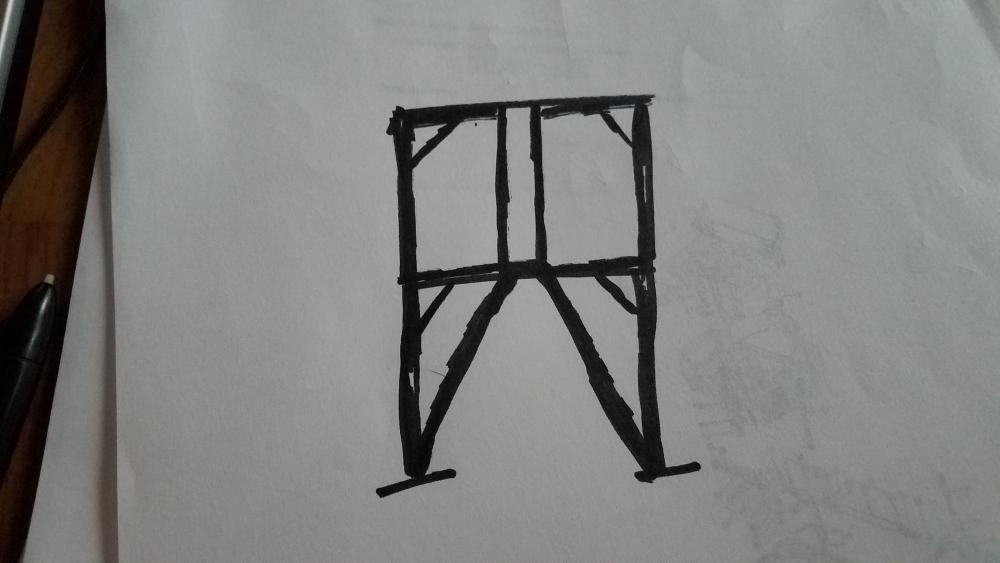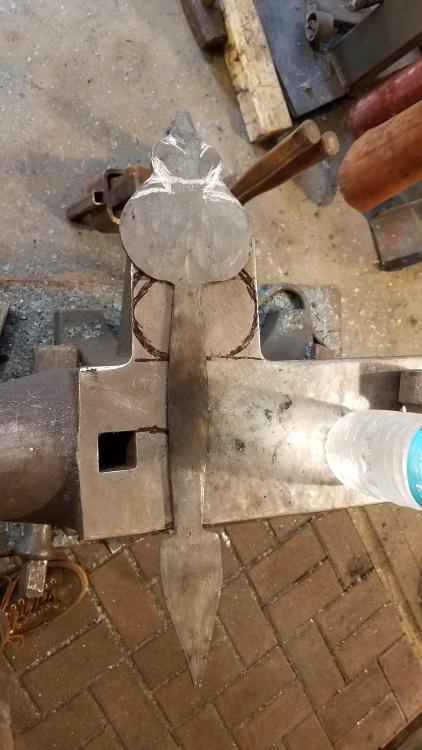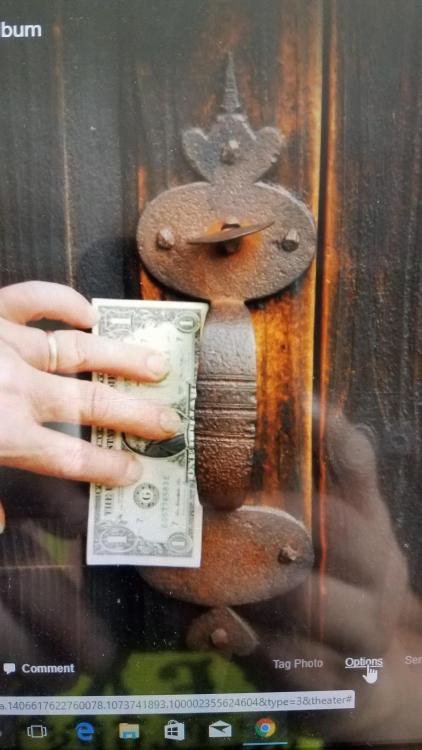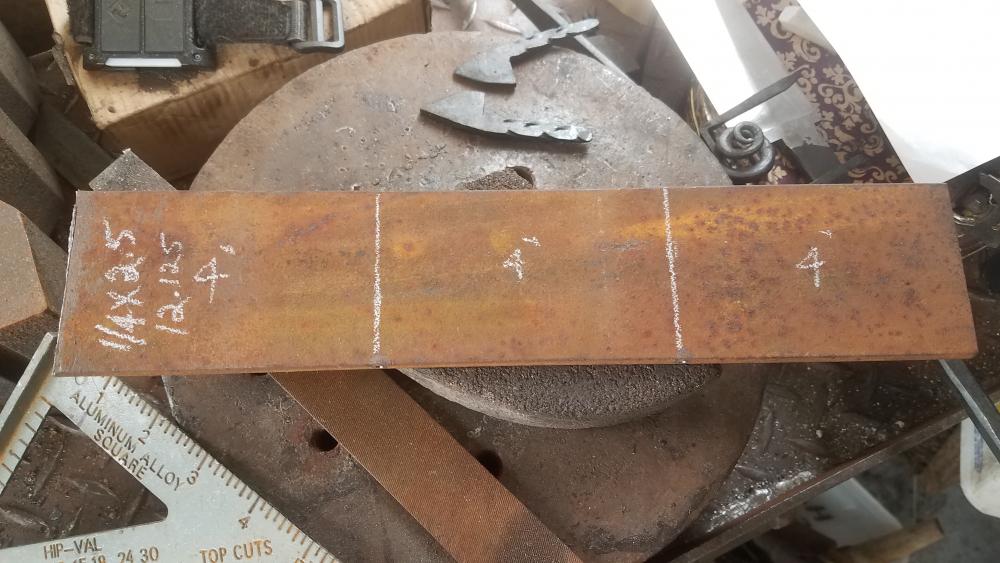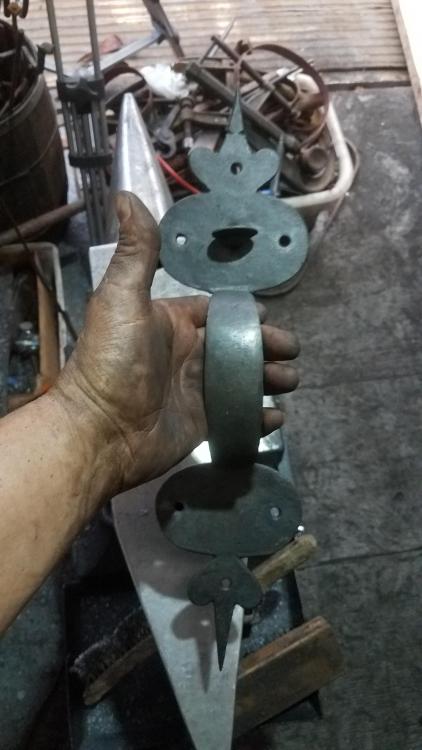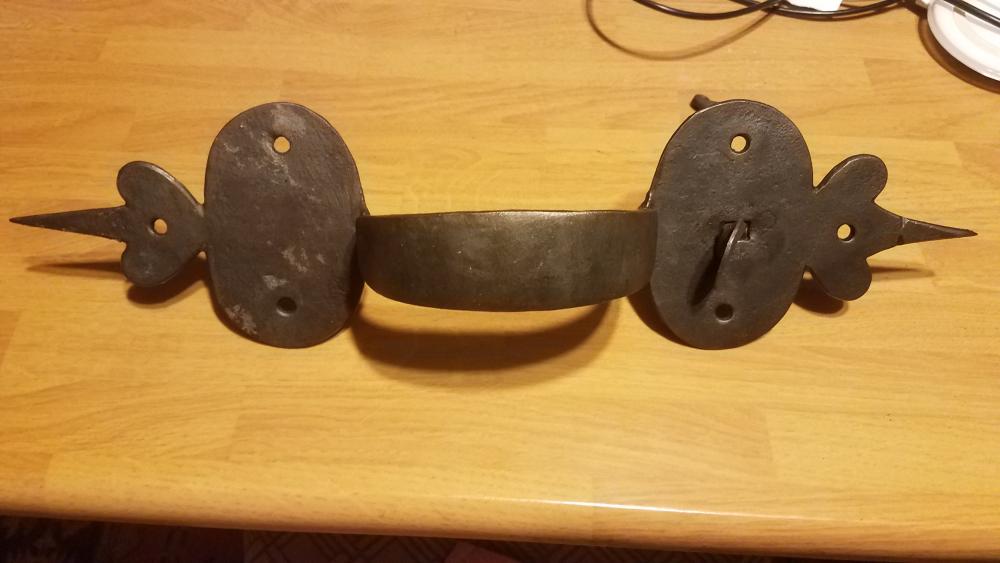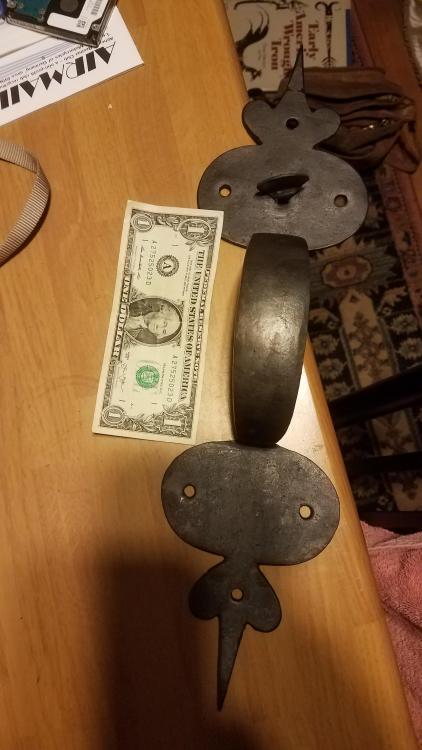-
Posts
5,824 -
Joined
-
Last visited
Content Type
Profiles
Forums
Articles
Gallery
Downloads
Events
Everything posted by jlpservicesinc
-
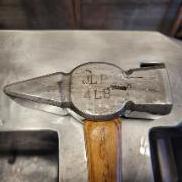
Show me your anvil stands
jlpservicesinc replied to pkrankow's topic in Stands for Anvils, Swage Blocks, etc
Yes, the cited information is correct.. The discussions we as a group have had for anvil height, body stance, etc etc.. All play into a limiting factor of there is only so many everythings with the body.. If I can get a 1/2 of % out of each hammer stroke with an increase in moving metal I will take it.. Or course a larger percentage is always better... I like getting 5% return on credit card cash back, 1% is better than 0... Anything is better than 0.. Someone starting out now has so many opportunities because of the easy access to not only the web but also local support groups.. ABANA has set standards for forge skills.. While I can work on any equipment even if it is skating across the floor or even not level or the blower doesn't work right.. It doesn't mean I want to for any length of time.. It's funny to me now, but really I have done the math with less than stellar mounts (not literally math) but working on wonky stands and equipment and while starting out doesn't need to be expensive as I am all for ALO's and dirt forges and such.. I even enjoy working on these things.. If there is a better more effective way for me to work to preserve my body while being effective.. I am all for it.. Best thing is with anything the only way to get good at something is to throw caution to the wind and go for it.. I used to make 50 or even 100 of something just to get better.. It was all fun.. Yes, we do.. -

Show me your anvil stands
jlpservicesinc replied to pkrankow's topic in Stands for Anvils, Swage Blocks, etc
No you did not.. But ths thread is not all about you.. Again its about sharing information.. Frosty now why did you go and get all silly.. Again, your information here to test it to the millionth or what ever is just silly.. You can see it and feel it as you work.. Why would you have to test for it. You guys seem to forget there are a lot of newer people who are looking for information.. While there are a million ways to mount and anvil and there are certainly better or worse ways.. All the dribble about how much flex or deviation or saying that springiness does not have to be accounted for is just ridiculous.. I do what I have found works consistently in the best way for my methods.. Really I don't argue.. I just give up.. It become not worth my time.. If there are better ways and to not acknowledge the ideas, shows a very immature attitude.. LOL.. There is a reason why anvils have a certain weight ratio to hammers and that ratio is still a compromise.. As is the case with a power hammer and foundation.. Your anvil stand is the foundation.. You don't find the information I shared worth it.. don't read it.. It's not meant for the guys who have it all figured out.. Wanna correct it.. Go for it.. But hey, you know all this stuff and your experience might be different or it may be true but you are willing to accept the bounce you have.. Besides that , there are a lot of super smart people on here who do amazing work.. It's all good... I just do what ever I want anyhow.. My stance , stands on making as solid a mount for anything you are going to be pounding on whether it's a vise, anvil, work bench, power hammer, all applies.. Everybody will do exactly as they want.. More power to them.. You have seen my work. It speaks for itself.. Good or bad. I'm just getting warmed up.. -

Show me your anvil stands
jlpservicesinc replied to pkrankow's topic in Stands for Anvils, Swage Blocks, etc
See this is why I love you guys.. I bet not one of you works on a wonkie stand or on an anvil that is not solidly mounted on a regular basis if you can help it.. So, what I am saying is.. Make the stand right or to the best of ones ability with the understanding that any give in the stand will lead to less work per hammer hit and yes 10 degrees in temperature does equate to less or more performed for a given function.. What is one thing that just about becomes a mantra to new students.. "Heat your steel up, it's to cold".. While 10 degrees doesn't mean much the effect of all things combined makes it tough to work to a higher level.. I work on others equipment once in awhile and find the same things over and over.. Takes nothing to make a mount solid.. I am merely sharing what lengths I go to, to get the performance I want.. And design and fabricate to that standard with plenty of good ol fashion trial and error just for the fun of it.. (not really).. -

Show me your anvil stands
jlpservicesinc replied to pkrankow's topic in Stands for Anvils, Swage Blocks, etc
Not quite sure what I want to do for anvil stands design wise when I get the school up and running but your design is the leader of the pack.. Simple in design, offering decent rigidity.. I have 40 i beams which might fit the build when the time comes.. Ideally I want to offer both wood and steel stands as well as gas, coal and wood fired forges with both electric or hand crank so people can experience the differences.. -

Show me your anvil stands
jlpservicesinc replied to pkrankow's topic in Stands for Anvils, Swage Blocks, etc
Frosty I would disagree strongly.. I've worked on Numerous stands,, Steel, cast iron, wood, Pipe, sand, steel shot, trailer floors, dirt. etc etc. We talk about ergrodynamic and why stand straight up and swing from a certain posture.. Etc etc.. What fails to get recongized by most is.. Work output is work output... If I can make something in 3 swings vs 6 swings of the hammer it becomes so important to work smarter.. From and engineering stand point you can mathamatically prove that there is a best ratio for an object moving at a certain speed and at a certain mass what the object will in theroy do or act.. Problem is we are not machines.. We are flesh and bone.. The dynamics on how we swing the hammer, the way we absorb that impact makes a world of difference.. 1/100000 of an improvement in how I can effect the metal I am moving means for 100000 swings of the hammer I have done that much more work.. LOL.. Every bit of energy I can put into moving the metal becomes so important at the end of an 8 or 10 hr forging day.. Also don't forget it's not just one day or 2 days.. It's hundreds of days with millions of hammer swings.. And yes, I can tell the difference between a good base/stand and a not so good one in 2 hits.. Again I disagree.. But you also have to keep in mind I look at this kind of thing from all facets of what or how I use the anvil.. I work with heavy hand hammers on the side of the anvil hitting back towards myself.. A 175lb anvil on a 230lbs stand will walk its way around the shop easily when working on the horn or heel.. Bending forks, long heavy bars, fulcrum points, only one arm to hold stuff while forging, small hammers, large hammers, For most newbies or intermediates it probably won't make a bit of difference.. But does this mean sloppy mounted anvils and stands should be the norm.. I know for a fact if you take a student who has only forged on a floppy anvil and you give them a solidly mounted one.. Which they will like better.. YOu will also see their work go up.. Now take them and put them on a solid stand, with anvil mounted soildly and again there is another increase.. What one has to ask themselves is" How much longer does it take to make a very well made stand vs making it again" once I figure out what I want or like? And again,, Yes, it does matter, flex and spring does matter.. If someone only uses a 1lbs hammer it won't make much difference but my largest hand hammer is 9lbs, my normal work hammer is 4lbs because I'm out of shape.. My normal work hammer once I get back in shape even though I'm 14years old I hope is a 6lbs hammer.. It certainly makes a difference.. Work smarter.. Not harder and yes it can be argued to buy a power hammer.. Ah, sounds like your working harder with big hammers.. LOL.. It really comes down to each there own.. Lead by example.. Work done, and speed which the work is done starts to show knowledge.. There is always someone smarter.. It becomes can they apply that being smarter to something that is applicable to what it is that is being done.. -

Show me your anvil stands
jlpservicesinc replied to pkrankow's topic in Stands for Anvils, Swage Blocks, etc
Hi Sorry about that.. I was thinking commercially made stand but a lot of the tripod stands are also weak in the knees.. The stand you fabricated is the best design for that sized and shaped anvil I have seen.. It uses the sides and webs of the I beam to reinforce and stablilize.. I would still add tie in's to all the feet to help with load spreading and then add a way to bolt it down solidly.. The heel of your anvil is within the foot print of the stand thus any shifting of the stand under load is decent enough to help with torsional rigidity.. It's the best in a tripod stand I have seen.. -

Show me your anvil stands
jlpservicesinc replied to pkrankow's topic in Stands for Anvils, Swage Blocks, etc
Lou L. Anytime you move a straight piece of steel at a slope and put weight on it you will lose rigidity.. It's the reason I did a complete rebuild on the stand in the trailer.. Using all straight pieces (with major gussets) vs sloped.. some would argue that because of the mechanics involved with kinetic energy and such that it becomes a moot point and from a strictly scientific study that may be the case.. Same reasoning with Ball bearng bounce on anvil faces.. I want as much rigidity in the stand as I can get and ideally the stand should be embedded in cement or bolted down solidly.. While a tripod stand will give you a non rocking setup on just about any surface a properly designed metal stand can be as rigid as solid but I don't see this in a tripod design no matter where or how I see the design.. You would have to reinforce the mounting plate with pre stressed girders with a huge amount of gusseting to stabilize the steel from flexing or bowing, springing with each blow as well as just supporting the anvil itself. Cement does very well in compression.. Say you have a 1/4" wall 3" sq tubing. 3ft long. If you add weight on the end of it standing up straight there will be deflection until the steel is compressed and the sides are tensioned enough to stabilize.. Fill the tube with cement and it will achieve rigidity nearly immediately when the load is applied.. Lolly column.. Steel being springy or flexible needs gussets or diagonals to stabilize any fabricated/welded item.. Both the black widow stand and the one in the trailer offer the stability and solidness I was looking for but both took a lot of desire and removal or design features I disliked vs ones I needed to have.. In other words I engineered out all the things I didn't like in a fabricated stand.. Again the problems with steel is how do you get rid of the spring.. The easiest way to minimize the spring is to get the legs straight up and down and gusset heavily to stop flexing of the side of the pipe, tube or solid.. +1 Unless they are all welded together with no air gaps between them.. -
Sorry about the Doggie.. Losing a family member is never easy.. Nice block with block.. That is a super popular option Or I should say I went for a visit with a fellow smith yesterday and he had the same style.. If I didn't know any better I'd think they were twins..
-
Lets back up a little bit... In days gone by they pretty much tried every configuration there was for a block or stand.. A lot of blocks had an option for a cast stand with the same basic design as what Ede has shown.. They also made them roundish with a center pivot.. They made them long with trunnions on each end.. They also had them with pins that you could pull out once turned into position.. all aimed at a certain working height.. on a square block it's pretty easy to make the correct working height for using the sides same or lower than anvil height.. You just put the groove that holds the block lower and build around this frame.. With a rectangular block this adds a lot more to the build as now you need a stand with 2 different depth of slots to get to that ideal working height.. I have 2 stands to make for rectangular blocks and then the square block will need modification.. The largest consideration is the type of use the block will get.. Light vs heavy use.. Flat vs edge use.. My big block has bolt heading sizes up to 2" shaft and the largest round is 4".. This will need a heavy stand with enough support in the center section to put all the pounding squarely transferred and on the ground.. Any flex in the frame means less than stellar performance.. The 2 rectangular blocks will need the 2 slots to be different lengths so you end up with the same work height for both the long and short side and do the same thing with putting the pressure right on the ground.. I will more than likely have the legs mounted off side vs onside like in the pictures.. This will offer both extra support for the block on edge and also flat but will complicate passed through use and is the reason the centers were left open..
-
Looks great.. I would have brought the center ones from the bottom slides to the feet at the legs.. This would have made the center section more resistant to flexing and springing when heavy sledge hammer use while standing on edge. Maybe a tie rod between the to legs as well.. If the stand is bolted down it will help with side load flexing on impact.. That would be the only thing I would do different.. It looks great..
-

Can welding "un-anneal" steel?
jlpservicesinc replied to lastcowboy32's topic in Welding/Fab General Discussion
A picture of the repair area always helps with making and educated reply.. Of the cuff it's very hard to tell from a description. I can tell you if the repair was done later it was more than likely a different material than originally used.. -

Deerfield Thumblatch
jlpservicesinc replied to jlpservicesinc's topic in Blacksmithing, General Discussion
thanks.. Still gots a little more file work to do.. Today I went up to help out a fellow smith on making the same latch but to a smaller size.. Was interesting as I worked on one side (cusp and half the handle length) and he the other.. Was a lot of fun.. Also a lot different because I use the tooling that is there vs bringing anything.. Not even my own hammer.. LOL.. "Where's your hammer".. What I'm supposed to bring a hammer:.. Really was a blast.. The guy does some really nice work.. This is how far we got before I had to leave.. Beautiful day for a motorcycle ride.. -

Deerfield Thumblatch
jlpservicesinc replied to jlpservicesinc's topic in Blacksmithing, General Discussion
Its kinda a neat place if you are into the old homes and hardware.. Old Sturbridge Village is another really good one.. Of course at OSV most of the hardware is newer but it still really neat to visit and see.. -
Well, since I have been getting stuff ready for the upcoming demos and the table is empty I decided to make a thumb latch for the table.. A recent introduction to a fellow blacksmith at the most recent demo peaked my interest when he said he needed a latch for his shop and was looking at making a copy of a latch at Old Deerfield Villiage in Deerfield MA.. I haven't been to ODV in maybe 30 years but new instantly which latch he was referring to.. He posted a pic to his FB page so today I made one.. It was really tough as all I had was a dollar bill for sizes.. I still need to add the finishing touches but it's whole.. Tomorrow I go visit the guy and we can do comparisons as he said he started making his..
-

So you think YOUR anvil's broken. ...
jlpservicesinc replied to D.C.'s topic in Anvils, Swage Blocks, and Mandrels
Score.. Nice find.. What does the top of the base look like and the botton of the anvil without being put back together now? -
Looks really nice.. Betcha it works great..
-

Interesting Catalog from 1904
jlpservicesinc replied to Big Bill's topic in Tools, general discussion
worked for me first try.. It's hard for me to believe this was a 1904 catalog.. The quality of all the grease and oil cups is amazing. Thanks for posting it.. -
It all becomes what something is worth to the person buying it.. I would never think about buying a hammer, tongs, hardies or the like as I can make them exactly to what I want.. Same with fabricated stuff.. But with that said it also becomes a time frame and the willingness to make what you need or want as well as the skill set.. Took me 4 years to start making decent tongs.. Excellent suggestions.. Big fan of making everything. Blacksmithing is about time at the forge, anvil, vise and hammer.. It's the only way to get good at it.. I still have my first hardies which were made from wood splitting wedges.. The steel was terribly soft but they lasted 15 years before I made a set out of better steel..
-
I bought my last anvil new.. It was a good decision.. If I had the extra money I would buy one again and the shipping was free..
-
In Reference to what? You want to buy tools and have them shipped to you? No one can read your mind.. You must put what you are actually looking for as well as condition, size and what you are willing to spend..
-
If your forging damascus a combination of press and hammer would be the best option.. For forge welding you want something to set the welds.. some prefer a power hammer for this task and some prefer a press.. A 4 post or a C frame would work.. Cycle times and tonnage become key.. If you have a lower tonnage it can stll work with smaller dies but it's not worth it.. A converted 24Ton and up hydraulic log splitter is a good starting point on the cheap or low down.. If you are serious and money isn't much of an issue. going with a dedicated and fabricated forging press would offer you anything you wanted.. There are many different types of presses out there and a 4 post is commercially more available as is a C press vs a 2post.. Now you didn't say what kind of nor what size material you want to weld together.. Not much of a hammer or press needed for 6mmX25mm.. but you start getting into 50mmX75mmX 150mm Well that is a whole different animal..
-
Some commecial 4 post presses are very fast.. They are made for commercial work.. Question becomes what is it you want to forge/make..
-
Lou very well said.. the ability to make something to a high standard will make work easier.. in the way back I had an apprentice of sorts.. Actually 2 of them.. They were my neighbors and brothers.. Scott was my first friend and striker.. He started when he was 11.. He became very good at striking but never had a desire to forge on his own.. His brother Clint on the other hand became a friend and striker and we studied martial arts together.. I eventually was able to get him to forge some items, Swords, knives, and Senban shurikens.. Each item he would make and be very proud of.. Covet them almost.. Like it was a gold standard.. When we would go out to practice, not to be mean, mind you but these are throw away items.. I would always take the prized item and throw it as far away as possible.. Of course he would get mad, but I would then say.. " This is merely one item of thousand you will be making.. To believe this one is perfect is full hardy and I am just helping you to break the strings of attachment.. (I myself was very young then) Back then I was making 10 of these an hour from 1/8" flat stock.. Years later he thanked me but at the time he would get so mad.. Reason why I brought up this story is because of the point you made.. Main equipment while talked about the most or coveted is just part of the whole experience and I have found making 1 nice item is merely a stepping stone and making consistently nice items and tools becomes the true signature of quality forgings.. Time spent forging if working towards a better forging is well worth it.. Practice becomes the way to perfection and I learned that time and time again..
-
I like it.. As long as the fool has something worth learning.. I learn stuff from people all the time.. while teaching people, even new people everybody has a way of looking at something in a different light.. As for getting burnt out.. That was me to a T.... The one that I don't think has been mentioned is " Looks really easy therefore it must be".... I used to get that one all the time..

